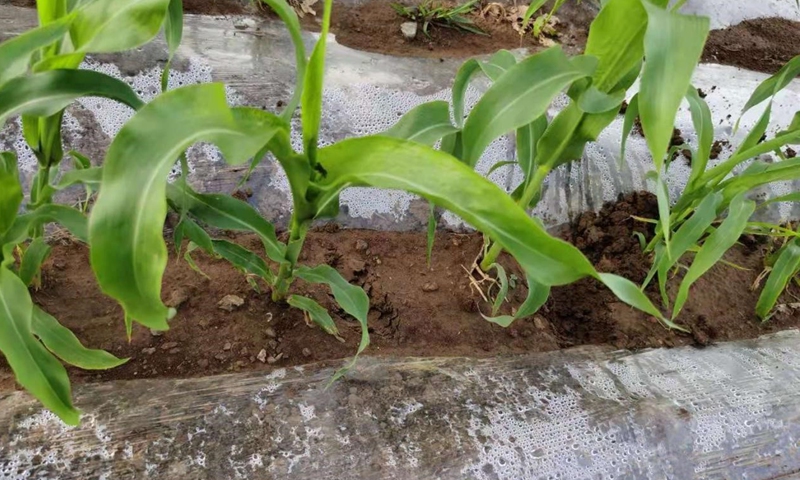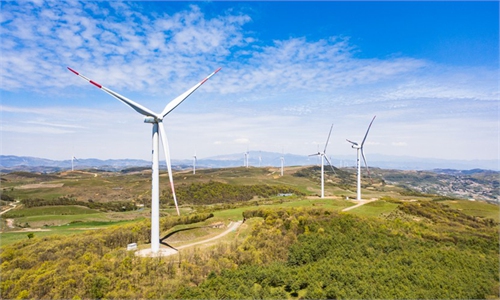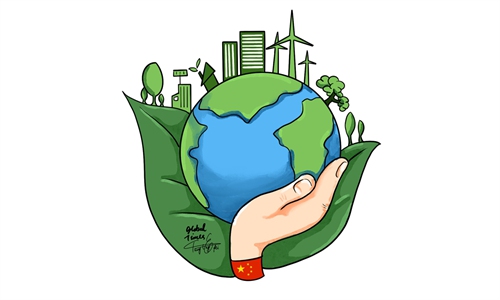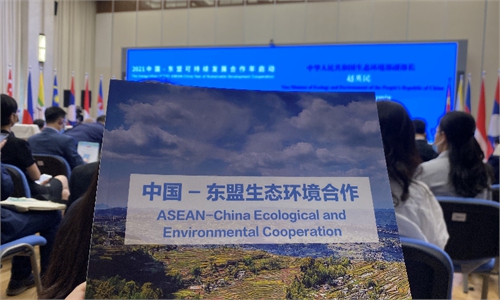China explores new ways of rural revitalization by combining poverty relief efforts with tackling climate change

The improved plastic mulching technique for dry farming used to grow corn in Xigou, Balin Left Banner, Chifeng city, North China's Inner Mongolia. Photo: Lu Yameng
"For local farmers, without support for production and income, all efforts to protect the ecosystem can easily wither away," Lin Kuocheng, Project Director of The Nature Conservancy (TNC), in North China's Inner Mongolia Autonomous Region, told the Global Times on Thursday while introducing a project in Xigou, Balin Left Banner in Chifeng city.
Since the project start in Xigou in 2019, Lin has spent most of his time in the village trying to explore new ways for rural revitalization by combining poverty relief efforts with tackling climate change.
In recent years, factors like climate change and irrational use of resources, have caused grassland degradation, water shortages and low river flows which have become increasingly prominent in Balin Left Banner.
"Facing these problems, we have initiated green solutions to improve the local environment and cooperated with the Three Gorges Corporation [TGC] to make our contributions to rural revitalization," Lin said.
Green solutions
The Chinese government has pledged that the country will hit peak carbon dioxide emissions before 2030 and will become carbon neutral before 2060 in response to climate change.
Agriculture, as the most sensitive and relatively vulnerable industry to climate change and one of the main responsible for carbon emission, also has a significant impact on climate change.
According to meteorological observations and data forecasts, the entire northeast region in China will see more rises in temperature caused by climate change, Lin told the Global Times during a visit, organized by the Institute of Climate Change and Sustainable Development of Tsinghua University, to Xigou.
"Although the overall precipitation in the local area has increased slightly in the past two years, local climate is showing a trend of aridification as the increase in precipitation is lower than the loss of evaporation caused by temperature rise," Lin mentioned, adding that "the trend is posing a serious challenge to the local agriculture and animal husbandry, as the Banner is in an arid and semi-arid region where water resources are already scarce."
In 2019, the TGC and TNC introduced an advanced dry farming technique in Xigou village that uses the measure of improved plastic mulching (thicker, stronger and easy to recycle) to suppress weeds, conserve water, and intercept sunlight to keep soil warm, which is especially important in Xigou as there is little precipitation in the early spring and temperatures can be very low for seeds to grow.
"If the plant seedlings grow well in the spring, there will be 60 percent of chance you can see a good harvest in the year," Liu Guofu, Director of the village of Xigou, told the Global Times on Thursday.
"With this technique, all rainwater can follow the path of the ditch and flow into the holes in the cover to be absorbed by the roots of the plants. There would be no waste of any drop of rainwater," Lin mentioned while demonstrating how the technique is being used in fields.
By using the technique , the yield of grain increased by 100 kilograms per mu (0.067 hectares) in the first year of experiment, Lin noted.
The technique is now being used in more than 4,000 mu ( 266 hectares) of arable land in the village, accounting for over half of its total arable land, expanded from 3,000 mu ( 200 hectares) in 2020 and 264 mu (17.6 hectares) in 2019.
Besides the dry farming technique, the TGC also cooperated with the TNC on the control of ditches caused by rainfall and soil erosion.
Liu recalled that several decades ago there were no ditches on the land, but because of soil erosion, they had emerged and became wider and deeper.
"In the largest ditch in the village, we constructed 11 control dams to reduce the speed of the flow of mountain torrents, prevent further expansion of ditches and replenish groundwater," Lin mentioned.
"To put it simply, a green solution means that we create conditions to prevent the continued deterioration of the ecosystem, block the path of environmental degradation, and leave the rest to nature and let it evolve by itself," Lin told the Global Times.

A control dam constructed in a ditch in Xigou, Balin Left Banner, Chifeng city, North China's Inner Mongolia. Photo: Lu Yameng/GT
Higher income and better environment for local people
On July 1, China declared the completion of the goal of taking China into a moderately prosperous society in all respects, marking the culmination of over four decades of relentless government efforts and Chinese ingenuity.
"In March, 2021, after 18 years of poverty alleviation help made by the TGC, the Balin Left Banner successfully announced it got rid of poverty," Zhang Yan, staff from TGC in Balin, told the Global Times.
At first, facing the questions and worries raised by the villagers, the TNC promised to provide the machinery, share the technique and supply the plastic cover for free. The villagers were only invited to provide their land and labor, according to Lin.
"Since the TGC provided assistance to Xigou village in 2019, it has invested more than 8.7 million yuan in project implementation with the TNC," Zhang mentioned, adding that "later, after a year of experimentation, our project gained the trust of farmers and a growing number of people began to join us."
Liu Guotai, a farmer in Xigou village, who is over 50 years old and needs to plant the 45 mu of land owned by his family, told the Global Times how his income has increased. "Before the new technique was introduced, all income depended on the weather. We did not know whether we would have a good harvest or not. But now, we are more confident about the spring season. Now my family can earn over 60,000 yuan [$9,258] each year."
Lin told the Global Times that, seeing the increase in grain output in Xigou, farmers from a neighboring village without any funding, came to learn from their experience and promote it throughout the region.



